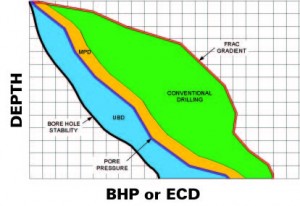Roads to UBD, MPD paved with ‘intentions’

Conventional, overbalanced drilling sometimes cannot fit the bill. Difficult drilling applications and easily damaged formations are classic examples in which conventional drilling can be confounded. In “UBD or MPD: An Engineering Choice Based on Intent (SPE/IADC 130563),” Ken Malloy, Stress Engineering Services, and Sara Shayegi, Hess Corp, drew sharp contrasts between these and similar techniques that included tips on appropriate applications for each.
Mr Malloy and Ms Shayegi presented a joint paper at the SPE/IADC Managed Pressure Drilling & Underbalanced Operations Conference, 24-25 February in Kuala Lumpur. The event’s platinum sponsor was At Balance with Smith, while Managed Pressure Operations was the silver sponsor and Halliburton an event sponsor.
The authors noted that the choices are not limited to MPD, UBD or conventional drilling. “The options really are UBO, MPD and mud cap drilling,” Ms Shayegi said. “Some people think mud cap drilling is a form of MPD.”
Instead, Mr Malloy suggested, mud cap drilling is a “man without a country.”

While underbalanced drilling can be traced back as far as the 1860s, when a well was first drilled with air, MPD is a more recent development that emerged in 2003.
“What we needed was a more balanced drilling technique that we really did not have,” Mr Malloy said.
“MPD is different than conventional drilling,” noted Ms Shayegi. “You are not going to look at things downhole as much. You are going to look at the choke.” This, she said, can be a challenge for a conventionally experienced driller.
The principal difference between UBO and MPD lies in intent. The intent of UBD is to maintain wellbore pressure below pore pressure in order to draw out formation fluids. Conversely, pressures in MPD are more closely controlled, the aim being to maintain wellbore pressure in near balance with pore pressure. In MPD, the intent is to avoid drawing formation fluids into the wellbore.
The IADC UBO & MPD Committee definition of MPD explicitly states that the technology’s intention is to “avoid continuous influx of formation fluids to the surface.” (Click here to see the committee website for the full definition).
In this sense, MPD and UBO are opposites, Mr Malloy said. Further, the technologies appeal to different applications. While MPD was developed to overcome drilling problems, such as lost circulation, stuck pipe, wellbore stability and well control, UB, by inviting a continuous influx, aims at minimizing formation damage and enhancing reserves and recovery.
In any event, solid planning is key to successful implementation of any drilling strategy, as is flexibility, Mr Malloy said: “It’s not like you have to set in stone that you are going to do MPD operations throughout the well or UB operations throughout the well or conventional operations throughout the well.”





One Comment